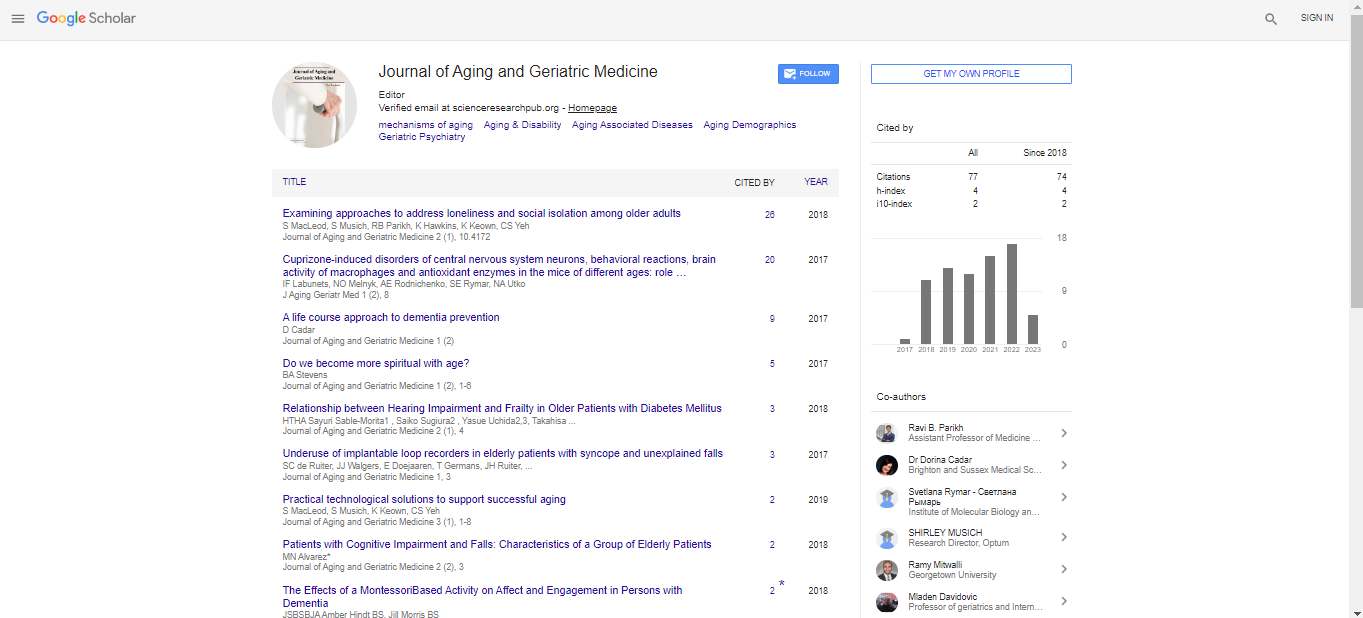Editorial, J Aging Geriatr Med Vol: 5 Issue: 12
Basal Ganglia in Idiopathic REM Sleep Behavior Disorder Parallels that in Parkinson’s Disease
*,
Department of Clinical Neurophysiology, John Radcliffe Hospital, Oxford, UK
Corresponding Author:
Michal Rolinski
Department of Clinical Neurophysiology, John Radcliffe Hospital, Oxford, UK
E-mail: michele.hu@ndcn.ox.ac.uk
Keywords: Aging, Aging Science, Cognitive Impairment. Geriatric Psychiatry, Gerontology
Description
Resting kingdom useful magnetic resonance imaging disorder in the basal ganglia community is a function of early Parkinson�??s disorder and can be a diagnostic biomarker of basal ganglia disorder. Currently, it's far uncertain whether or not those adjustments are found in so-referred to as idiopathic fast eye motion sleep behaviour ailment, a circumstance related to a excessive price of destiny conversion to Parkinson�??s disorder. In this examine, we discover the application of resting kingdom useful magnetic resonance imaging to come across basal ganglia community disorder in fast eye motion sleep behaviour ailment. We evaluate those statistics to a fixed of wholesome manipulate topics, and to a fixed of sufferers with mounted early Parkinson�??s disorder. Furthermore, we discover the connection among resting kingdom useful magnetic resonance imaging basal ganglia community disorder and lack of dopaminergic neurons assessed with dopamine transporter unmarried photon emission automatic tomography, and carry out morphometric analyses to evaluate gray rely loss. Twenty-six sufferers with polysomnographically-mounted fast eye motion sleep behaviour ailment, forty eight sufferers with Parkinson�??s disorder and 23 wholesome manipulate topics have been blanketed on this examine. Resting kingdom networks have been remoted from task-loose useful magnetic resonance imaging statistics the usage of twin regression with a template derived from a separate cohort of eighty aged wholesome manipulate participants. Resting kingdom useful magnetic resonance imaging parameter estimates have been extracted from the examine topics withinside the basal ganglia community. In addition, 8 sufferers with fast eye motion sleep behaviour ailment, 10 with Parkinson�??s disorder and 10 manipulate topics acquired I-ioflupane unmarried photon emission automatic tomography. We examined for discount of basal ganglia community connectivity, and for lack of tracer uptake in fast eye motion sleep behaviour ailment and Parkinson�??s disorder relative to every different and to controls. Connectivity measures of basal ganglia community disorder differentiated each fast eye motion sleep behaviour ailment and Parkinson�??s disorder from controls with excessive sensitivity (96%) and specificity (74% for fast eye motion sleep behaviour ailment, 78% for Parkinson�??s disorder), indicating its ability as a trademark of early basal ganglia disorder. Rapid eye motion sleep behaviour ailment became indistinguishable from Parkinson�??s disorder on resting kingdom useful magnetic resonance imaging no matter apparent variations on dopamine transported unmarried photon emission automatic tomography. Basal ganglia connectivity is a promising biomarker for the detection of early basal ganglia community disorder, and might assist to become aware of sufferers susceptible to growing Parkinson�??s disorder withinside the destiny. Future danger stratification the usage of a polymodal method ought to integrate basal ganglia community connectivity with medical and different imaging measures, with essential implications for destiny neuroprotective trials in fast eye motion sleep behaviour ailment.
Significant abnormalities in resting kingdom useful MRI have formerly been said through our organization in the basal ganglia community (BGN) of sufferers with early Parkinson�??s disorder. While this method indicates promise as a diagnostic biomarker withinside the early motor stages of Parkinson�??s disorder, it's far uncertain whether or not those adjustments are found in prodromal disorder.
Over the beyond 20 years, growing proof has emerged for idiopathic fast eye motion (REM) sleep behaviour ailment (RBD), taking place withinside the absence of every other clinically described neurological ailment, being related to the prodromal ranges of some of neurodegenerative conditions, predominantly Parkinson�??s disorder. Therefore, RBD can be taken into consideration because the most powerful predictor of neurodegeneration to be had through far, with many RBD sufferers displaying early capabilities of neurodegenerative conditions. Cheap, secure and dependable way of figuring out the ones at maximum danger of growing Parkinson�??s disorder might facilitate the centered use of novel disorder-editing remedies and revolutionize medical trials on this field.
 Spanish
Spanish  Chinese
Chinese  Russian
Russian  German
German  French
French  Japanese
Japanese  Portuguese
Portuguese  Hindi
Hindi 